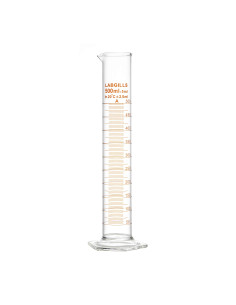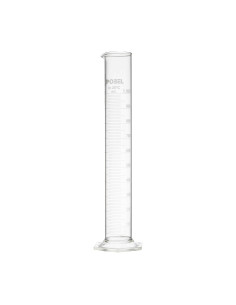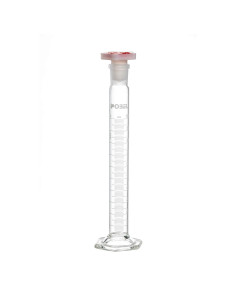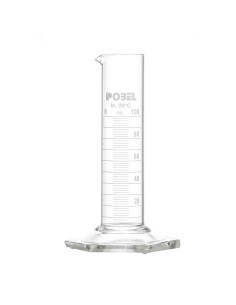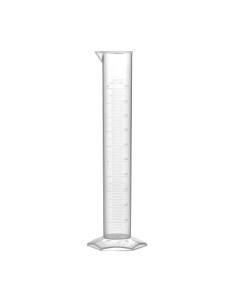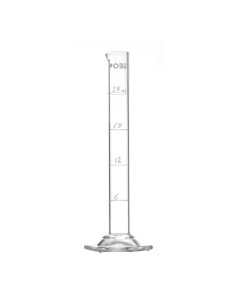Cylinders are essential instruments in laboratories and various industries for the precise measurement of liquid volumes. Their cylindrical, graduated design allows professionals to take accurate measurements, which are crucial in scientific experiments, industrial processes, and educational applications.
What is a Cylinder and What is it Used For?
A cylinder is a cylindrical container, typically made of glass or plastic, with graduations along its length indicating different volumes. It is primarily used to measure and transfer liquids accurately in laboratory settings. In addition to liquid measurement, cylinders play a crucial role in solution preparation, mixing, and experiments where volumetric accuracy is essential.
Main Types of Cylinders and Their Characteristics
There are several types of cylinders, each adapted to specific needs. Below are the most common ones:
- Glass Cylinders: made of borosilicate glass, they offer high resistance to thermal changes and aggressive chemicals. They are ideal for applications requiring sterilization and high precision.
- Plastic Cylinders: made of materials such as polypropylene, they are impact-resistant and compatible with a wide range of chemicals. They are lightweight and less prone to breakage, making them suitable for educational settings or fieldwork.
- Graduated Cylinders: feature graduation marks along their body, allowing for precise volume measurement. Available in various capacities and materials.
- Cylinders with Stopper: equipped with a stopper to store samples without risk of contamination or evaporation. Useful in procedures that require liquid retention over time.
- Class A Cylinders: meet stricter precision standards and are often individually certified. Used in applications where accuracy is critical.
- Class B Cylinders: provide adequate precision for most general laboratory applications, though with slightly higher tolerances than Class A cylinders.
To explore the full range of available cylinders, visit the cylinders section on Pobel.
Differences Between Cylinders, Pipettes, and Volumetric Flasks
While cylinders, pipettes, and volumetric flasks are all volumetric measurement instruments, they have key differences:
- Cylinders: ideal for measuring and transferring varying volumes of liquids. Their vertical design and stable base facilitate use in various applications.
- Pipettes: elongated instruments designed to measure and transfer specific small volumes of liquid with high precision. Essential in titration techniques.
- Volumetric flasks: Containers with a single mark indicating an exact volume. Primarily used for preparing solutions of precise concentrations.
The choice between these instruments depends on the required precision and the specific nature of the task.
Standards and Certifications in Cylinder Manufacturing
The accuracy and quality of cylinders are supported by international standards. Class A and B cylinders must comply with standards such as ISO 4788, which specifies design, material, and tolerance requirements. Additionally, many Class A cylinders come with individual calibration certificates, ensuring their accuracy and traceability.
Materials Used in Cylinder Manufacturing
The most common materials used in the manufacturing of cylinders include:
- Borosilicate Glass: resistant to high temperatures and most chemicals. Offers excellent transparency, facilitating the reading of graduations.
- Polypropylene (PP): a plastic material resistant to impact and a wide range of chemicals. It is autoclavable and suitable for applications requiring sterilization.
The choice of material depends on factors such as the nature of the liquids being measured, working conditions, and sterilization needs.
Tips for Using and Maintaining Cylinders
To ensure accuracy and prolong the lifespan of cylinders, follow these recommendations:
- Proper Cleaning: wash cylinders immediately after use with appropriate detergents and rinse with distilled water.
- Correct Storage: store cylinders in racks or stands designed to prevent falls or damage.
- Avoid Extreme temperatures: Do not expose cylinders to sudden temperature changes to prevent material stress.
- Regular Calibration: periodically verify the accuracy of cylinders and recalibrate if necessary.
How to Choose the Right Cylinder for Your Application
Selecting the right cylinder depends on several factors:
- Type of Liquid: for corrosive substances, borosilicate glass cylinders are preferable. For less aggressive solutions, plastic cylinders may suffice.
- Required Precision: if the application demands high accuracy, opt for Class A cylinders. For general tasks, Class B cylinders are suitable.
- Volume to Be Measured: choose a cylinder with a capacity that matches the volume you need to measure, avoiding the use of a large-capacity cylinder for small volumes, as this may compromise accuracy.
At Pobel, we offer a wide range of cylinders tailored to various needs and applications.
Pobel Cylinders
At Pobel, we take pride in providing high-quality cylinders manufactured under strict international standards. Our products are designed to meet the demands of precision and durability in laboratory and industrial environments. By choosing our cylinders, you benefit from:
- Variety of Materials: we offer cylinders in borosilicate glass and polypropylene, suitable for different applications.
- Diverse Designs: our range includes graduated cylinders, stoppered cylinders, Class A and B cylinders, among others, to meet all your needs.
- Certified Quality: our Class A cylinders come with individual calibration certificates, ensuring maximum accuracy.
We invite you to explore our full range of cylinders and contact our team of experts for guidance in selecting the most suitable instrument for your requirements.
Frequently Asked Questions
What is the difference between a graduated cylinder and a test tube?
A graduated cylinder has markings along its body that allow for the precise measurement of different liquid volumes. In contrast, a test tube, also known as an assay tube, is a small cylindrical tube without graduations, primarily used to contain, mix, or heat small amounts of substances in experiments.
How is a cylinder properly calibrated?
To calibrate a cylinder correctly, fill it with distilled water at room temperature and compare the measured volume with the actual value using a certified reference standard. In some cases, an adjustment or correction factor may be necessary if deviations are found.
Which material is best for a laboratory cylinder?
It depends on the application: Borosilicate glass cylinders are ideal for applications requiring high precision and chemical resistance, while polypropylene cylinders are more durable and impact-resistant, making them suitable for educational or industrial settings.



